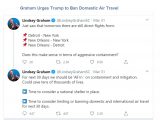
AI Arms Race: Future of Warfare
April 2, 2020April 2, 2020 (Gunnar Ulson - NEO) - The truth about artificial intelligence (AI) and the process of machine learning (algorithms which learn on their own rather than perform tasks based on human programming) is somewhat less spectacular than depicted in Hollywood movies. Yet the impact of advanced information technology on modern warfare will be significant nonetheless.
Already, machine learning is allowing automation including self-driving cars and analysis by computers that by far surpass average human abilities. It is development that is already having a significant impact on national and global economics. If we translate this process to various aspects of modern warfare, it becomes clear that whomever does so first and most effectively, will have an immense advantage over their adversaries.
This may explain why there is an AI "arms race" so to speak. The US, Russia and China are all racing to develop not only applications in AI and machine learning, but also investing in the human resources and building the infrastructure to continue to do so at accelerated rates.
China already has the second largest number of researchers involved in AI, second only to the United States. Both it and other states are continuing to invest in AI and its various sub-disciplines, fully aware of the impact this technology is increasingly having on economics as well as national security.
The OODA Loop
US Air Force Colonel John Boyd developed what is now known as the OODA Loop. OODA represents the process of observing, orienting, deciding and acting. This process is not only one still employed by the US military (all branches) but also a process adopted by many businesses.
It requires first and foremost the ability to not only accumulate immense amounts of information during the "observe" process, but also requires the ability to make sense of that information. Human analysts are limited by the amount of information they can sift through, and even then they are limited by various human flaws that may prevent the successful interpretation of information they do sift through.
AI on the other hand, is able to sift through immense amounts of information, at incredible rates and with accuracy repeatedly proven to be superior to human analysts.
To get a grip on the scale we're discussing, consider the fact that Facebook has AI algorithms that sift through, identify the faces and objects within and accurately tag a monumental 350 million photographs... daily.
In a 2017 talk at the US Naval War College, Admiral John Richardson would impress upon the audience two key points.
First, today with information technology and sensors (including satellites, ground sensors and information available across the Internet), a massive amount of information is now available strategically and tactically for military commanders. Second, whichever nation is able to accumulate and make sense of this information the fastest will have an edge over its adversaries.
The "observe" and "orient" processes of the OODA loop currently and in the future depend on the ability to acquire and make sense of this information, providing commanders with the most crucial information from among the vast amount of info available in order to "decide" and "act."
An AI algorithm able to process images, text and other forms of information by the hundreds of millions within a single day and accurately categorize and prioritize it is clearly a tool that will be essential for future warfare.
The United States, both across public and private institutions and enterprises, is investing deeply in developing the ability to do this and to do it better than other nations.
AI Arms Race: Racing Toward Global Balance?
The OODA Loop was originally conceived as a means of creating an agile military able to overcome the brute force of a much larger but less agile enemy. Today, it is a blade that cuts both ways. The US, which conceived and openly develops the OODA Loop, continuing today to augment it with AI and machine learning, could find itself either the agile military outcompeting larger but less agile enemies, or outcompeted by nations who are more successful at integrating AI and machine learning into their own intelligence and decision making processes.
Currently it is not clear who has the greatest advantage regarding AI. Even with the US possessing the largest number of total AI researchers as well as the largest number of top researchers, AI has not been able to make a significant difference for the US in terms of its declining economic and military might.
With other nations fully aware of the impact AI is having and will have in the future, all while fully investing in this discipline and attempting to catch up to the US, it is doubtful the US ever will acquire a significant advantage in terms of AI alone. And integrated together with other aspects of military and economic activity, it appears that a balance of power is developing between nations that no amount of innovation within the US alone will yield the sort of technological edge the US used to dominate the planet for nearly a century.
This is perhaps a hopeful development. It means that the US will need to reorient itself, to constructively compete and collaborate among other nations rather than operate above them. But in order to ensure this much more appealing future, other nations must continue investing in and developing tools and capabilities like AI to ensure such a balance of power emerges and is sustainable.
Gunnar Ulson, a New York-based geopolitical analyst and writer especially for the online magazine “New Eastern Outlook”.
Already, machine learning is allowing automation including self-driving cars and analysis by computers that by far surpass average human abilities. It is development that is already having a significant impact on national and global economics. If we translate this process to various aspects of modern warfare, it becomes clear that whomever does so first and most effectively, will have an immense advantage over their adversaries.
This may explain why there is an AI "arms race" so to speak. The US, Russia and China are all racing to develop not only applications in AI and machine learning, but also investing in the human resources and building the infrastructure to continue to do so at accelerated rates.
China already has the second largest number of researchers involved in AI, second only to the United States. Both it and other states are continuing to invest in AI and its various sub-disciplines, fully aware of the impact this technology is increasingly having on economics as well as national security.
The OODA Loop
US Air Force Colonel John Boyd developed what is now known as the OODA Loop. OODA represents the process of observing, orienting, deciding and acting. This process is not only one still employed by the US military (all branches) but also a process adopted by many businesses.
It requires first and foremost the ability to not only accumulate immense amounts of information during the "observe" process, but also requires the ability to make sense of that information. Human analysts are limited by the amount of information they can sift through, and even then they are limited by various human flaws that may prevent the successful interpretation of information they do sift through.
AI on the other hand, is able to sift through immense amounts of information, at incredible rates and with accuracy repeatedly proven to be superior to human analysts.
To get a grip on the scale we're discussing, consider the fact that Facebook has AI algorithms that sift through, identify the faces and objects within and accurately tag a monumental 350 million photographs... daily.
In a 2017 talk at the US Naval War College, Admiral John Richardson would impress upon the audience two key points.
First, today with information technology and sensors (including satellites, ground sensors and information available across the Internet), a massive amount of information is now available strategically and tactically for military commanders. Second, whichever nation is able to accumulate and make sense of this information the fastest will have an edge over its adversaries.
The "observe" and "orient" processes of the OODA loop currently and in the future depend on the ability to acquire and make sense of this information, providing commanders with the most crucial information from among the vast amount of info available in order to "decide" and "act."
An AI algorithm able to process images, text and other forms of information by the hundreds of millions within a single day and accurately categorize and prioritize it is clearly a tool that will be essential for future warfare.
The United States, both across public and private institutions and enterprises, is investing deeply in developing the ability to do this and to do it better than other nations.
AI Arms Race: Racing Toward Global Balance?
The OODA Loop was originally conceived as a means of creating an agile military able to overcome the brute force of a much larger but less agile enemy. Today, it is a blade that cuts both ways. The US, which conceived and openly develops the OODA Loop, continuing today to augment it with AI and machine learning, could find itself either the agile military outcompeting larger but less agile enemies, or outcompeted by nations who are more successful at integrating AI and machine learning into their own intelligence and decision making processes.
Currently it is not clear who has the greatest advantage regarding AI. Even with the US possessing the largest number of total AI researchers as well as the largest number of top researchers, AI has not been able to make a significant difference for the US in terms of its declining economic and military might.
With other nations fully aware of the impact AI is having and will have in the future, all while fully investing in this discipline and attempting to catch up to the US, it is doubtful the US ever will acquire a significant advantage in terms of AI alone. And integrated together with other aspects of military and economic activity, it appears that a balance of power is developing between nations that no amount of innovation within the US alone will yield the sort of technological edge the US used to dominate the planet for nearly a century.
This is perhaps a hopeful development. It means that the US will need to reorient itself, to constructively compete and collaborate among other nations rather than operate above them. But in order to ensure this much more appealing future, other nations must continue investing in and developing tools and capabilities like AI to ensure such a balance of power emerges and is sustainable.
Gunnar Ulson, a New York-based geopolitical analyst and writer especially for the online magazine “New Eastern Outlook”.


